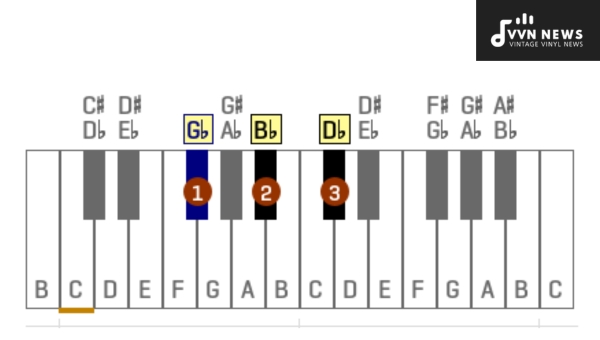Having a fascination with music theory, I have always found the beauty of chords captivating. Among these captivating chords, one that holds a special allure for me is the G flat major triad.
There is an ethereal quality intrinsic to this chord and once you dive into its magical universe, it feels like you are touching the fabric of harmonious sound itself.
We hear different kinds of music every day and believe it or not – the versatility of the G flat major triad can enrich your listening experience manifold.
I am excited to share my insights with you, hoping that this shared knowledge will help you appreciate your favorite tunes even more – because when you know what’s happening beneath those lilting melodies, trust me, they become even more enjoyable.
What is the G Flat Major Triad?
The G Flat Major Triad is a three-note chord composed of the notes G♭, B♭, and D♭. It is significant in music theory as it is one of the major triads derived from the G♭ Major scale.
The triad represents the root (G♭), the major third (B♭), and the perfect fifth (D♭). In terms of musical notation, it can be represented as G♭, Gb, or F#.
This triad is crucial for musicians as it forms the basis for creating harmonies and melodies in the key of G flat major.
With its distinct sound and versatility, mastering the G Flat Major Triad opens up a world of possibilities in music composition and performance.
Why is the G Flat Major Triad Significant?
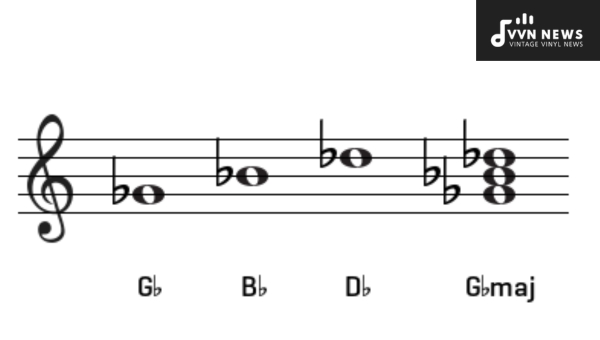
The G Flat Major Triad plays a crucial role in music theory and composition. Here are some reasons why it is significant:
Harmony and Melody
- The G Flat Major Triad provides a strong foundation for creating harmonies and melodies in the key of G Flat Major.
- Its unique combination of notes (G♭, B♭, and D♭) produces a rich and vibrant sound, adding depth to musical compositions.
Key Significance
- As one of the major triads derived from the G♭ Major scale, the G Flat Major Triad represents an essential element in this key.
- Mastering this triad enables musicians to navigate through songs written in G flat major more confidently.
Chord Progressions
- The G Flat Major Triad can be found in various chord progressions, making it indispensable for creating catchy and memorable musical phrases.
- How this triad fits within different progressions allows musicians to create dynamic arrangements and explore different tonalities.
Versatility
- While the triad is commonly associated with classical music, it has been widely embraced across various genres, including jazz, pop, and rock.
- Its versatility allows musicians to incorporate it into their compositions or improvisations, adding color and emotion to their performances.
Transposition
- The G Flat Major Triad serves as a gateway for transposing music into different keys.
- By grasping its structure and relationship to other chords within the key of G flat major, musicians can easily transpose songs or build chord progressions in other keys.
Mastering the G Flat Major Triad brings several benefits to musicians. Its significance lies in providing harmonic clarity, facilitating composition and improvisation in the key of G flat major, offering versatility across genres, supporting chord progressions, and enabling transposition.
By mastering this essential triad, musicians gain a deeper understanding of music theory and open doors to creative possibilities in their musical endeavors.
Also Read: G Major Scales And Chords [Expand Your Musical Understandings]
Building the G Flat Major Triad
Building the G Flat Major Triad requires recognizing its structure and the relationships between its constituent notes. Here’s a step-by-step guide to constructing this triad:
- Start with the G♭ Major Scale: The G♭ Major scale consists of the notes G♭, A♭, B♭, C♭, D♭, E♭, and F.
- Identify the Root Note: The root note of the G Flat Major Triad is G♭. It serves as the foundation for the chord.
- Determine the Third: In a major triad, the third is composed of two whole steps above the root note. In this case, count two whole steps above G♭ to find B♭.
- Find the Fifth: The fifth is located four whole steps above the root note. Count four whole steps from G♭ to find D♭.
- Combine the Notes: Once you have identified G♭ (the root), B♭ (the major third), and D♭ (the perfect fifth), you have successfully built the G Flat Major Triad.
Practice playing these three notes together on your instrument or visualizing them on a keyboard or staff notation.
Please familiarize yourself with their sounds and how they harmonize when played simultaneously.
Different Inversions of G Flat Major Triad
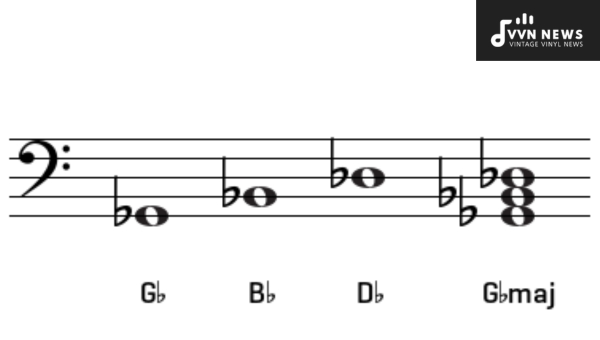
Inversions play a crucial role in music composition and can add depth and variety to your playing. The G Flat Major Triad has three inversions, each with a unique sound and voicing. Let’s delve into each inversion to understand their structure and how to play them.
1. Root Position
The root position of the G Flat Major Triad is when the root note (G♭) is at the bottom, followed by the major third (B♭), and then the perfect fifth (D♭) stacked on top. In the root position, the notes are played in sequential order from lowest to highest.
2. First Inversion
In the first inversion of the G Flat Major Triad, we take the third (B♭) as the new root note. This means that B♭ will be played at the bottom, followed by D♭, and then G♭ on top.
3. Second Inversion
The second inversion of the G Flat Major Triad occurs when we take the perfect fifth (D♭) as the new root note. This gives us D♭ as the lowest note, followed by G♭, and then B♭ on top.
It’s important to familiarize yourself with each inversion as it allows you to create different harmonic structures that can add character to your playing.
Each inversion exhibits a unique sound quality while still maintaining its relationship to G Flat Major.
Mastering different inversions of chords like the G Flat Major Triad will not only expand your musical vocabulary but also enhance your overall musicality.
Also Read: D Major: The Scales And Chords [Broaden Your Musical Vocabulary]
Inversions of G Flat Major Triad on Guitar and Piano
When it comes to mastering the G Flat Major Triad on instruments like the guitar and piano, its inversions are crucial.
Inversions refer to rearranging the order of notes within a chord while keeping the same root note. This technique adds depth and variety to your playing.
Inversions on Guitar
On the guitar, inversions of the G Flat Major Triad can be achieved by changing the positions of your fingers while maintaining the same root note (G♭). Here are three common inversions:
- Root Position: In this inversion, the root note (G♭) is played as the lowest note in a chord shape, with B♭ and D♭ stacked above it. The shape can be played by barre-chording all three strings at the 4th fret or using individual fingers on each string.
- First Inversion: For this inversion, start with B♭ as your lowest note, followed by D♭ , and then G♭ as the highest note. This inversion provides a different voicing for the triad and can be played by barring strings 3-5 at fret 9 or using individual fingers on each string.
- Second Inversion: In this inversion, D♭ becomes the lowest note, followed by G♭ in a higher octave, and then B♭ as the highest note. To play this inversion on guitar, barre strings 2-4 at fret 11 or use individual fingers.
Inversions on Piano
On the piano, inversions offer a unique way to explore different voicings within the G Flat Major Triad. Here’s how you can achieve each inversion:
- Root Position: Begin with your right-hand fingers on G♭, B♭, and D♭. The thumb corresponds to G♭, the middle finger to B♭, and the little finger to D♭. Play them simultaneously or arpeggiate the triad from bottom to top.
- First Inversion: For this inversion, move the G♭ (root note) up an octave. Place your thumb on B♭, the middle finger on D♭, and the little finger on G♭ in a higher octave.
- Second Inversion: Start with your thumb on D♭ (the root note shifted further up), place your middle finger on G♭, and use the little finger for B♭ in a higher octave.
Remember to practice these inversions slowly at first before gradually increasing your speed. Additionally, you can experiment with different rhythms and arpeggiations to add flavor to your playing.
Practicing the inversions of the G Flat Major Triad will broaden your musical capabilities as a guitarist or pianist.
These inversions allow you to explore different tonal colors and create more complex harmonies within the context of the triad.
Also Read: E Major: Scale And Chords [Exciting Sounds For Your Compositions]
Triads Within the G Flat Major Triad Scale
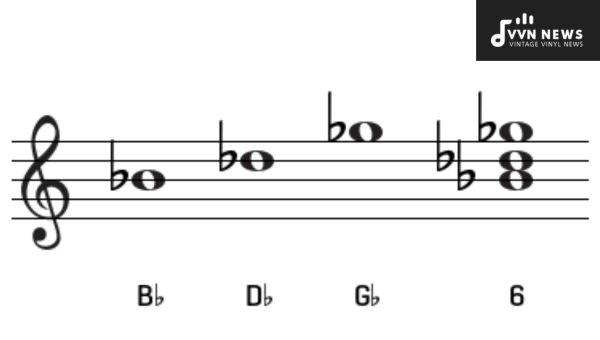
The G Flat Major Triad is derived from the G♭ Major scale, which consists of the notes G♭, A♭, B♭, C♭, D♭, E♭, and F. Let’s explore the various triads that can be found within this scale:
Gb Major
The Gb Major triad consists of the notes G♭, B♭, and D♭. It is built on the first degree of the G♭ Major scale and is known for its bright and uplifting sound.
Ab Minor
The Ab Minor triad comprises the notes A♭, C♭(B), and E♭. It is built on the second degree of the G♭ Major scale and has a melancholic and reflective quality.
Bb Minor
The Bb Minor triad is formed by combining the notes B♭, D♭(C#), and F. It is built on the third degree of the G♭ Major scale and exudes a somber and passionate character.
Cb (B) Major
Cb (B) Major triad consists of Cb (B), Ebb(D#), and Gb(F#). It is constructed on the fourth degree of the G-flat major scale. While rarely used due to its enharmonic spelling with B major, it shares similar tonal qualities with other major triads.
Db (C#) Major
Db (C#) Major triad is composed of Db(C#), F(Bbb/A#), and Ab(G#). Formed on the fifth degree of the G-flat major scale, this triad possesses a strong sense of resolution and stability.
Eb (D#) Minor
The Eb (D#) Minor triad consists of the notes E♭(D#), G♭(F#), and B♭. It is built on the sixth degree of the G♭ Major scale and evokes a bittersweet and soulful quality.
F Diminished
The F Diminished triad is formed by combining the notes F, A♭, and C♭(B). It is constructed on the seventh degree of the G♭ Major scale and has a tense and mysterious sound.
Within the G Flat Major Triad scale, we have Gb Major, Ab Minor, Bb Minor, Cb (B) Major, Db (C#) Major, Eb (D#) Minor, and F Diminished.
Each triad offers its unique emotional color to your compositions or improvisations. Properly incorporating these triads will enhance your music with depth and variety.
Also Read: F Sharp Major Chords [Boost Your Guitar Skills Today]
How to Practice the G Flat Major Triad on Instruments?
Practicing the G Flat Major Triad on instruments is essential for musicians looking to expand their skills and explore new musical avenues.
Here are some detailed steps and techniques that will help you master the G Flat Major Triad on instruments like guitar and piano:
- Structure: Before diving into practice, it’s crucial to understand how the G Flat Major Triad is constructed. The triad consists of three notes: G♭, B♭, and D♭. Familiarize yourself with these notes on your instrument’s fretboard or keyboard.
- Start by playing individual notes: Begin by playing each note of the triad separately. This will help you develop finger strength and familiarity with each note’s sound. Take your time to ensure accuracy and clarity.
- Practice in different positions: Once you are comfortable playing individual notes, start exploring different positions of the G Flat Major Triad on your instrument. Experiment with different octaves and string sets on the guitar or various hand positions on the piano.
- Play the triad ascending and descending: After mastering separate notes and positions, practice playing the triad in an ascending and descending pattern. This exercise will improve your dexterity and muscle memory.
- Use inversions: Experiment with inversions of the G Flat Major Triad by rearranging the order of its notes (G♭, B♭, D♭). This will give you a different sonic color while maintaining the essential characteristics of the triad.
- Play along with a metronome: Use a metronome or drum loop to practice rhythmic precision while playing the G Flat Major Triad. Start slow and gradually increase your speed as you become more comfortable.
- Experiment with chord progressions: Incorporate the G Flat Major Triad into various chord progressions. This will help you understand its harmonic function within different musical contexts.
- Explore arpeggios: Practice arpeggios based on the G Flat Major Triad, playing each note individually and in a sequential pattern. This exercise will improve your finger coordination and overall technique.
- Transpose to different keys: Once you have mastered the G Flat Major Triad, challenge yourself by transposing it to different keys. This will expand your musical versatility and ability to adapt to various musical situations.
By incorporating these steps into your regular practice routine, you will develop a strong foundation in playing the G Flat Major Triad on your instrument of choice.
Frequent Progressions Using the G Flat Major Triad
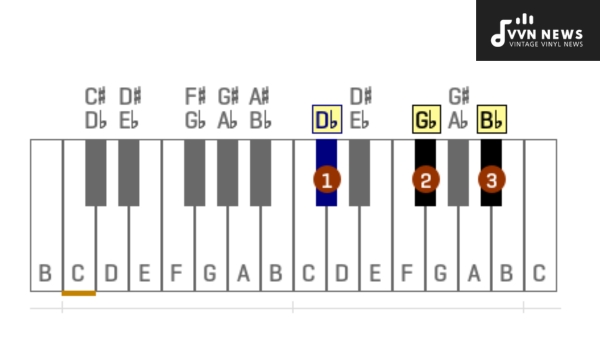
Mastering the G Flat Major Triad opens up a wide range of possibilities for creating beautiful progressions in your music.
Determining how the triad fits into different chord progressions will help you compose and improvise with confidence.
Here are some common progressions that incorporate the G Flat Major Triad:
I – IV – V Progression
This classic progression is found in countless songs across various genres. In the key of G flat major, it would consist of the chords G♭, C♭, and D♭. Experiment with different rhythms and voicings to add your unique touch.
ii – V – I Progression
In this progression, the G Flat Major Triad serves as the tonic chord (I). Combine it with an F♭m7 (ii) to D♭7 (V) for a Latin or jazz-inspired sound. This progression creates a strong resolution back to the tonic.
vi – IV – I Progression
This progression is commonly found in pop and rock music. Starting with E♭m (vi), moving to C♭ (IV), and then resolving to G♭ (I). It has a catchy and uplifting feel that works well in many songs.
I – vi – IV – V Progression
This popular progression can be heard in numerous hit songs throughout history. G flat major includes the chords G♭, E♭m, C♭, and D♭. The G Flat Major Triad serves as the foundation while creating an emotional and melodic journey.
Remember to experiment with inversions, arpeggios, and various rhythms to create your unique sound within these progressions.
Also Read: A Flat Diminished Triad [Delve Into Rare Guitar Chords]
Well-Known Songs Featuring the G Flat Major Triad
Music is a universal language that connects people across cultures and generations. The G Flat Major Triad has found its way into numerous well-known songs, creating memorable melodies and captivating harmonies.
Here are some notable examples where the G Flat Major Triad plays a significant role:
- “I Will Always Love You” by Whitney Houston: This iconic ballad, originally written and performed by Dolly Parton, showcases the G Flat Major Triad in the opening piano chords. The use of this triad sets a melancholy tone that matches the heartfelt lyrics of the song.
- “I Can’t Help Myself (Sugar Pie Honey Bunch)” by Four Tops: A classic Motown hit, this song features the G Flat Major Triad prominently in its catchy chorus. The uplifting sound of the triad perfectly complements the joyous and soulful nature of this timeless tune.
- “Endless Love” by Lionel Richie and Diana Ross: In this romantic duet, the G Flat Major Triad appears during the soaring chorus, adding depth and emotion to this heartfelt declaration of love. Its placement within the song highlights its ability to evoke powerful emotions.
- “My Heart Will Go On” by Celine Dion: Known as the theme song from Titanic, this ballad utilizes different variations of the G Flat Major Triad throughout its emotional journey. It contributes to the grandeur and drama that encapsulate this unforgettable movie soundtrack.
- “Don’t Stop Believin'” by Journey: As one of rock music’s anthems, this song features a memorable piano intro where you can hear glimpses of the G Flat Major Triad. Its presence adds a touch of sophistication to an otherwise energetic and uplifting track.
The use of the G Flat Major Triad in these songs demonstrates its ability to enhance musical compositions with texture, emotion, and intrigue.
Whether it’s in a pop ballad, soulful Motown hit, or a power ballad, the G Flat Major Triad has proven to be a versatile and influential musical element.
By listening to and analyzing the application of the G Flat Major Triad in these well-known songs, you will develop a deeper knowledge of how to incorporate it into your musical compositions.
It is through studying these examples that you can tap into the creative potential of this triad and use it as a tool to evoke specific feelings and emotions in your music.
FAQs about the G Flat Major Triad
Can I use the G Flat Major Triad in any genre of music?
Yes, absolutely! The G Flat Major Triad can be applied to various genres, including jazz, classical, pop, and more. Its versatility allows for creative expression in a wide range of musical styles.
How do I build the G Flat Major Triad?
To build the G Flat Major Triad, start with the root note G♭ and stack a major third interval (B♭) and a perfect fifth interval (D♭) on top of it. This creates the foundation for the triad.
What are the different inversions of the G Flat Major Triad?
The first inversion of the G Flat Major Triad is B♭-D♭-G♭, where B♭ becomes the lowest note. The second inversion is D♭-G♭-B♭, with D♭ as the lowest note. These inversions provide unique voicings and tonal options for musicians.
How can I practice playing the G Flat Major Triad on guitar or piano?
You can practice playing the G Flat Major Triad on guitar by using barre chords or open positions on different frets. On piano, explore different hand positions and fingerings across multiple octaves to strengthen your proficiency.
Which well-known songs feature the G Flat Major Triad?
Songs such as “All You Need Is Love” by The Beatles and “Titanium” by David Guetta featuring Sia prominently use the G Flat Major Triad in their melodic progressions. Learning to play these songs will help you understand how this triad fits into real-world musical contexts.
Conclusion
Mastering the G Flat Major Triad is an essential skill for musicians looking to enhance their musical repertoire.
With the theory behind this triad and exploring its various inversions, you can unlock new possibilities in your playing.
Whether you play guitar, piano, or any other instrument, practicing the G Flat Major Triad scales and incorporating them into your compositions will greatly improve your musical abilities.
From well-known songs to frequent progressions, the G Flat Major Triad offers a rich and unique sound that can elevate your musical creations.
So grab your instrument and start exploring the depths of the G Flat Major Triad today.
